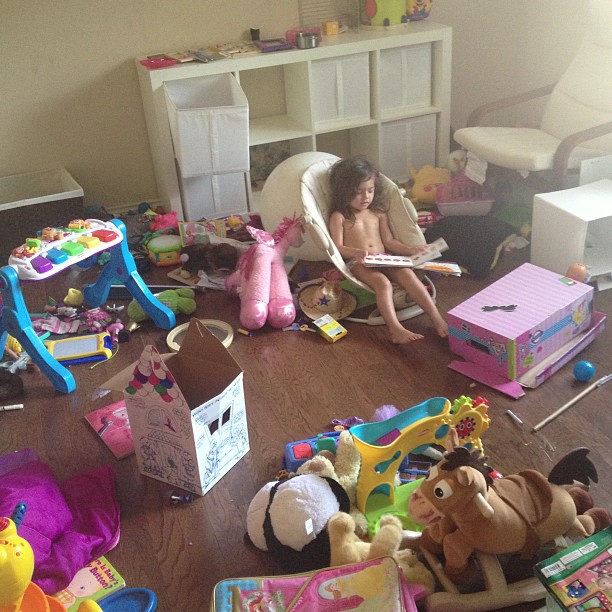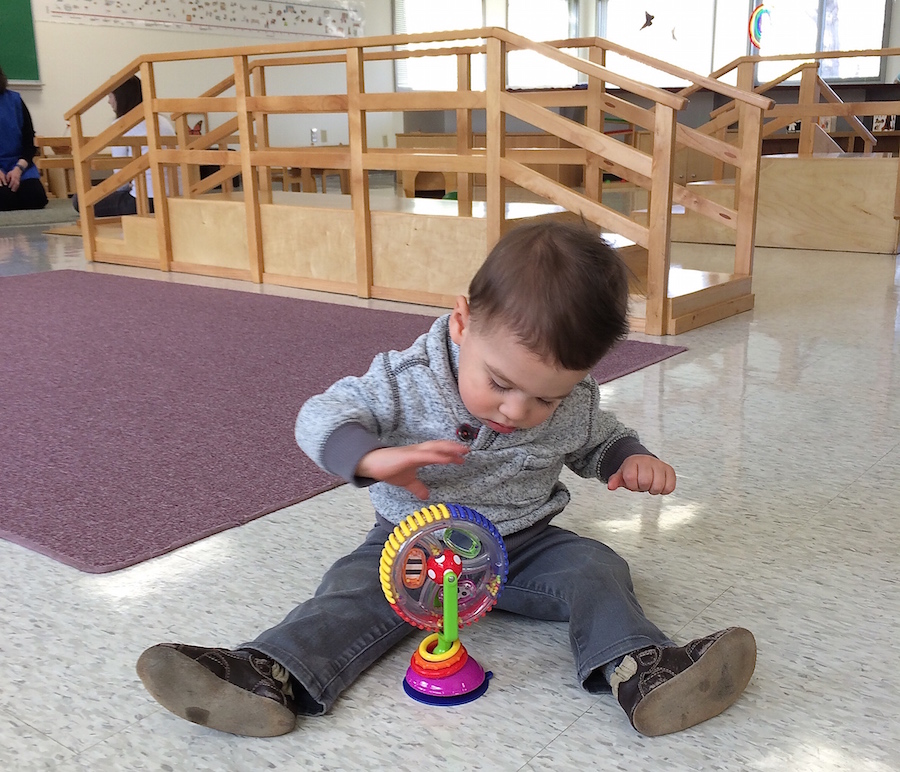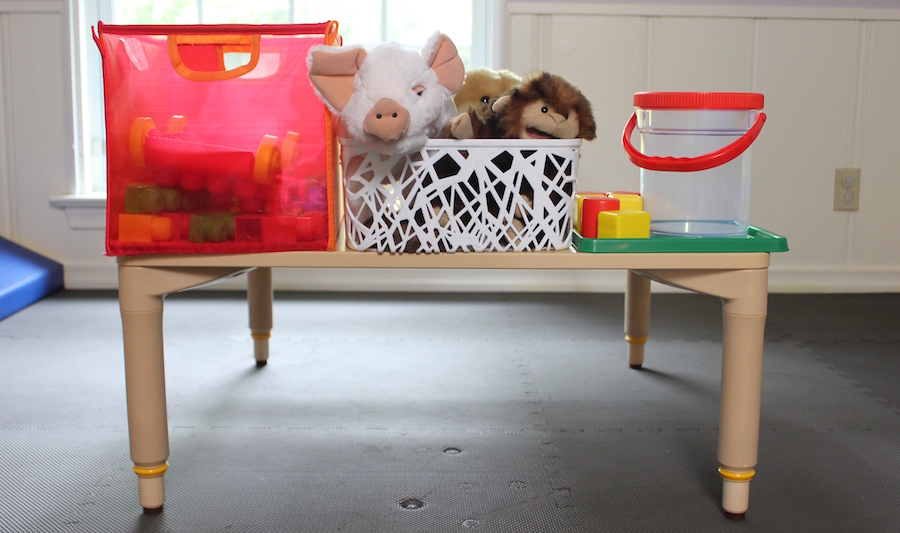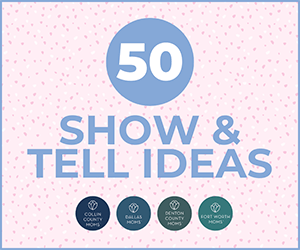Recently I shared why I got rid of my wardrobe. But long before I tackled my closet, I took on the toys. I vowed there would be no more stepping on Legos in the middle of the night and tripping over blocks. Too many toys are a safety hazard and a sanity hazard.
I have to argue that any child would be completely overwhelmed with a selection of toys as lengthy as the Cheesecake Factory Menu. Just like I felt about my wardrobe, I believe maintaining a short “fine-dining” menu of higher quality, carefully chosen toys is a better fit for children.

So I knew what I didn’t want: toy chaos. What I did want was a tranquil space for my son to play independently. After all, we know kids learn through play. So I pictured his playroom to be like his office. The place were the real work (a.k.a playing) gets done.
We started to learn about a child’s “work” when we enrolled Nicolas in a playgroup in our neighborhood. It was at a Montessori school–which we didn’t know a thing about. The first week, my husband David took him to the group. David came back from the group with an excited but confused mix of feelings. He explained to me that the classroom felt empty–maybe even a little boring.
David told me everything in the classroom had its place. Each toy in the classroom had its own little basket and a special spot on the shelf. And the rule was that each child should only play with one toy at a time, and put it away when they are done. Groundbreaking, right? What’s more, he said that all of the kids were completely engaged in the few toys the room had to offer. There was no mischief-making…no one trying to unload the teacher’s cupboards, bite their friends, or run out of the room. I was intrigued.

The following week I observed it myself for the first time. After my first observation, I was sure that the school was lacing the Kool-Aid with a special rule-following medication. Either that or it was a cult. I couldn’t get over how well the children played independently. They were completely absorbed and occupied in their tasks at hand. I was determined to figure out what the secret was so I could jump on the bandwagon and bring it home.
I started to read a little more on the school’s philosophy behind their seemingly minimalist classrooms. I quickly came across a blog post entitled “There’s just too much stuff.” It resonated with me because, like most of America, we.just.have.too.much.stuff. I found out the answer to my problem was having fewer toys, and picking the right toys. To quote the author:
The things we surround ourselves with are not always lovely, not always useful or meaningful. In our house, we have closets and a garage full of things we don’t really need or use. We have living spaces that are cluttered with toys, books, games, art projects and the like. Often these things have missing or broken pieces…What I will do is be more deliberate about what we really need, what is truly engaging, and what is lovely and pleasing to us. I intend to be more thoughtful in how these things are arranged, displayed and organized. Nothing is stacked or hidden, nothing is in a toy box or in cluttered bins. The children can see the materials, can access them easily, and can put them away with ease.
And with that quote, I was sold. Hook, line, and sinker.

We created our son’s office playroom in a way that we hope he will be learning and playing in for years to come. Is it extreme? Yes, absolutely. But we have already seen how wonderful it has been for his play, development, and sanity (heck, mostly our sanity). Here’s how we did it.
1. We started with a completely bare space. Starting with an empty play room allowed us to add each item in one-by-one with careful consideration.
2. We got the right organizers. Toy boxes and large bins are a bottomless pit that invite dumping. Instead, we have trays and short (6 inches) containers that can easily be accessed without mess making. These types of storage containers ensure that the items are easy to see, easy to access, and contained.


3. We found a toy-style. Just like people have different clothing styles, there are also different toy styles. This grandma’s toy-style really stuck with me.
Several years ago, I was trying to find a hobbyhorse, the kind that has a horse’s head on a stick, for my youngest granddaughter who had fallen in love with all things horsey. Much to my surprise, I could never find one that didn’t make all sorts of horse sounds and play cowboy songs — we quickly removed the batteries. A silent horse allowed her to create her own sounds and stories.
Our toy-style includes mostly toys that are task-based (a shape sorter, a puzzle—generally toys that you can “complete” or master). We also try to incorporate many open-ended toys, much like the silent horse.

Although it may be controversial, we request “no gifts” at birthday parties. Our close family and friends spend time with him and are familiar with our toy-style. They tend to purchase great additions to his space. If we do receive a gift thats not “our style”, we try to repurpose it or donate it to a good cause. If someone gifted me some jeans that were clearly too small or weren’t my style, it is unlikely to would wear them. I don’t think the use of toys should be much different.
4. We changed how we buy toys. Rather than sticking to the birthdays and holidays to buy toys, I buy them year around. We have a “one-in-one out” policy, with 15 toys and 8 books in the playroom at any given time. I buy toys used as much as possible. And when he outgrows them, I put them into storage for our future children.
I don’t get sucked in to things that “look super fun”. I buy toys all year to meet his developmental needs and interests-which are always changing. Once he masters the chunky shape puzzles, it’s time to move onto the jigsaw. Keeping the toys appropriate for his current age keeps him engaged. If the room was filled with toys that were too baby-ish or too mature, he would either ignore them or play with them inappropriately.
5. We keep variety. I always make sure to keep at least one of each of following types of toys: Gross motor, fine motor, plush, stacking, building, connecting, puzzles, pretend play, musical play, art play, and of course books–the books are rotated regularly.
6. We keep it minimal. I rarely put out an entire set of anything. Does he really need access to all 300 Mega Blocks that came in the set? No. Usually 50 will do the job. And he only needs one Thomas the Tank Engine. He does not need Birthday Thomas, Musical Thomas, Light-up Thomas, AND Halloween Thomas. Setting boundaries helps to free up space in the room and makes for easy clean up.
Speaking of clean up…it’s so easy. If I do it myself after bedtime it takes me 1 minute and 20 seconds (yes, I timed it) to put everything back in perfect working order. If Nicolas helps, it obviously takes a bit longer. It’s not always clean. And he doesn’t always (or even usually) put away the toys as he plays. But I feel good about where we are at right now.

I don’t want to spend the next decade yelling at my kids to clean up their toys. If the toys are manageable they will not only be easier to clean up, but easier to get out and enjoy.
And he does enjoy them. Nicolas is an incredibly happy, busy little man. I feel confident that these toys provide him with a lot of fun and numerous opportunities of exploration and creativity.
What do you think of our toy philosophy? I know it will get challenging as he gets older. And even more challenging as we think about adding more children to our family.
Do you think you could make something similar work in your house?
This Dallas Moms Blog original post was featured on August 13, 2015 by The Today Show. We’re proud of our website and the amazing expertise all of our contributors bring to this collaborative website! You can see the video here:
[xyz-ihs snippet=”Today-Show–Rid-of-Toys”]














I worked in a Montesorri day care, the picture looks like one of ours. I wish I had known about montesorri when my kids were little. It taught me so much , even down to sitting at a table for meals. It is a great working tool for all mothers with small children.
I agree Jan! We use many Montessori tactics at meal time and throughout the day and have had a lot of success. Thanks for reading!
LOVE everything about this! My one year old son has more than he (or his parents) knows what to do with! Can I ask where you got all your storage solutions/table/chairs? I love the simplicity! Thanks!
Thank you for writing this. You made many really great points. I have often thought of doing this for the toddlers and babies. I have a child at each stage of development, literally ever stage! Nine children from 8 months to nearly 18. We also homeschool. Do you have suggestions for creating a play space that could incorporate multiple ages?
Wow, you are a busy lady! Maybe you should be giving the advice 🙂
I haven’t really thought about managing that many children. But my first thought would be I wonder if you could divide the room up into areas or “centers” like schools do. An area for art, music, cooking, etc…and then incorporate materials for different sizes of hands and developing minds mixed together. For example, in the art area you have several different types of paint from finger paint on up to tempera. And different sized brushes as well. This way the kids of various ages could work on similar projects collaboratively.
It would require the older ones to step up and take some responsibility for making sure the younger ones get the appropriate materials for their age. But I am sure there is already a lot of team work going on in your house 🙂
Thanks for reading!
Noooooo….
Have the MINIMUM of centers with a lot of kids and the MAXIMUM of flexible spaces. (And also…NO ART SUPPLIES in the playroom with a large number of kids. Art should be done at the kitchen table or some other place under much tighter adult supervision, where little CAN’T get into it. And REAL instruments should be kept away from small children, with the exceptions of sturdy and inexpensive things.
An open space with MAYBE a table and most of what parents with one or two kids make into “centers” in self-contained buckets instead are the the way to go to have enough different spaces for toys and activities across the age ranges. The more kids and the wider the age spread, the less space you’ll have for a train table or a riding horse. You have to become SUPER-selective about larger things.
If you have a closet in the playroom, I’d put a bolt on it and make the closet for big-kid toys. Tiny kids can climb like monkey if they have a reason to. I don’t have that space, unfortunately!
So great! Have you read ‘simplicity parenting’? It tackles this exact topic as well as many others regarding home life to ensure that kids have the space and grace to develope properly.
I haven’t! But I need to check out that book. Putting it on my list!
Thanks for reading Natalie 🙂
Denaye
cribtotable.com
My children attended a Montessori school, and their children are doing so now. Toys at my home are similarly stored/displayed – each activity in its own bin/basket “lives” in the same space on the same shelf every day. Each must be put back before a new one is chosen. Outgrown toys are put up, and only brought out when youngest grandchild comes to play. My one point of disagreement with the above – books never go away. My grandchildren are currently enjoying books I read to them when they were younger as well as books I read to their parents.
I should clarify, we have 8 books in the playroom. We have 4 acrylic shelves, and 2 books on each shelf. I like them to face out so he can see them and choose from them. As he gets older we may add more and line them up on a shelf.
We also keep small bins with 2-3 books in them throughout the house. One in his bedroom, one in our bedroom, and one in our office. He always has access to an assortment!
perhaps when he is older, look into the rain gutter type shelving from Ikea? that way many books can be on display for him to choose. I always lament the lack of available wall space for my own 5 children to have that sort of access. And again, when he is much older. store books in low edged baskets, so he can flip through titles and have more variation as to what might strike his interest that day 🙂
I wish I could re do so much of my children’s lives so i could implement the knowledge I have now, with the bumbling efforts I had as they were babies. ( mine are 15,13,10,8 and 6)
You nailed exactly how I want our toy philosophy to be for our little man due in August. My parents were immigrants who didn’t have money to get us toys when I was a kid. I had to be creative and actually spend quality time with family (what a concept!) I will be able to afford more for our son now, but I want to spoil him with love and knowledge, not so many toys. Thank you for laying out exactly my thoughts! And great job parenting so far 😉
Starting before he is born is the best way to go! Make sure you are really clear with family members about your intentions…everyone gets so excited and it’s easy for toy-buying to get out of hand quickly 🙂
Thanks for reading!
Denaye
(cribtotable.com)
I love the idea behind this and we have implemented the one in, one out rule for toys. How do you start this for older kids–elementary aged, who should have more decision making input in the process? We have tried donating and selling to provide an incentive to clean out items that are not used or infrequently used but there still seems to be an abundance of stuff.
Thanks for reading! Personally, this is what I would do.
I would observe them closely for at least a week, taking notes on the toys they are playing with. Make sure to keep what they obviously love. I would then have them leave for the day and do what you need to do–getting everything else out. I would buy at least one larger, open-ended toy to replace the smaller things. Or maybe give the room (s) a makeover with new paint or fun posters for the wall–whatever you think will excited them. They will need to see the change as a positive thing and focus on the “gain” rather than the loss.
With time they will come to enjoy their spaces more, but it could be a difficult transition nonetheless.
Simply love it Denaye! What are your plans for kids of different ages when it becomes a shared space? I can’t imagine how to implement this for all three of my different aged children. Thoughts? Thanks!!!
Good questions…I wish I had a good answer 🙂
Just some of my initial thoughts…I think an important thing to decide will be how your family is going to treat toys and “property”. Some families say that “everything belongs to everyone” and others believe that each child has their own space and belongings.
If every child has their own things, it can be pretty easy to put the “big kids” stuff in their respective bedrooms.
If everything is “community property” then it makes sense to put it all together. You might organize by theme, so all the art stuff is together for example. The art equipment might incorporate materials for children of various ages–which is great because they can play and create together despite their age differences.
There is a Montessori principle called “control of error” that I really love. Basically it means you just put everything available in small amounts…so if it gets dumped or spilled, it’s really not a big deal to clean it up. You could apply this to blocks, legos, paint, water, whatever it is. Smaller children are more likely to spill and make a mess of things, but you don’t want to completely take away the messy stuff from the siblings because of it
Love this article. I have three girls ages 10, 5 and 3. My 10 year old has been spoiled as the first grandchild on both sides for a very long time and we kept all her stuff really nice. The second one then had the toys and got more toys that suited her wants and needs. Then the 3rd had an enormous amount of toys plus her own and it got to be way too much. Especially since my now 3 year old was never interested in “baby” toys. They too have a designated play room that they trash all the time. I am currently in the process of decluttering all rooms/closets and the playroom. This weekend took out a lot from the play room and I noticed too that they were actually playing with toys afterwards and were engaged in them. Not just throwing them around and stepping around them. My new rule is that if at the end of the night anything is on the floor it is out the door. My biggest struggle is gifts during holidays and birthdays. Right now we have been trying to save up for a nice swing set by asking for cash or gift cards. But we end up with another doll or something else that sits. I have a bin of unopened toys too that I try to re gift but my older kids have caught on and I think they are embarrassed knowing that we did not go out and buy it. We are trying to implement with grandparents and close family to either contribute to a big family gift or take them out for one on one experiences or sleep overs. They actually said those were there favorite gifts!
It sounds like you are making big strides! Nice work:)
Could you return some of those gifts for gift cards to use toward the large gifts? If I got someone a gift and found out they returned it to walmart for a gift card toward a big gift because they don’t keep many toys in their house, I wouldn’t mind at all!
This is great!! As a former teacher, this makes complete sense. Thanks for sharing.
Excellent article. Well written with specific examples to support the general thesis. I want to apply this philosophy not just to my child (soon to have twin siblings), but to our entire household.
We have so much stuff that we can’t remember what or where half of it is. So when we actually need something we already have, we can’t find it or have forgotten about it, and we end up buying another of the same thing that’s already somewhere in our house! Result: even more stuff.